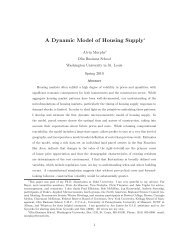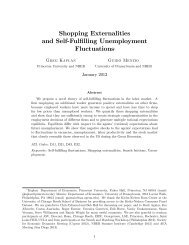Homework Assignment #3: Answer Sheet
Homework Assignment #3: Answer Sheet
Homework Assignment #3: Answer Sheet
- No tags were found...
Create successful ePaper yourself
Turn your PDF publications into a flip-book with our unique Google optimized e-Paper software.
Econ 434<br />
Professor Ickes<br />
<strong>Homework</strong> <strong>Assignment</strong> <strong>#3</strong>: <strong>Answer</strong> <strong>Sheet</strong><br />
Fall 2008<br />
This assignment is due on Thursday, November 20, 2008, at the beginning of class (or<br />
sooner) .<br />
1. Consider the graphical model of the gold standard. Analyze graphically (be sure to distinguish<br />
impact effects from long-run effects. Assume the economy started in full equilibrium) what<br />
happens to the price level and the stock of gold if:<br />
(a) there is a fall in foreign income.<br />
brief answer A decrease in foreign income reduces exports so the flow supply of gold<br />
will decrease. This causes the stock of gold to fall. Given the demand for gold the<br />
relative price of gold must rise. Under the gold standard this requires the price level<br />
to fall. This makes us more competitive. Once the price level rises sufficiently the<br />
flow supply of gold is once again equal to the flow demand and the stock of gold<br />
stops changing. The gold stock is now lower than before and the relative price of<br />
gold is higher.<br />
(b) credit cards reduce the need for money in making transactions<br />
brief answer This reduces the monetary demand for gold. The same level of transactions<br />
can be made with the same level of gold. With the demand for gold decreased<br />
the relative price of gold must fall. At the lower relative price, the flow supply of<br />
gold is below demand. The gold stock decreases, and this raises the relative price of<br />
gold until we reach equilibrium. Notice that the new equilibrium price level is the<br />
same as before as long as the flow supply and demand curves do not shift. What<br />
happens is that the gold stock is lower than in the initial equilibrium.<br />
(c) gold discoveries occur in some faraway land.<br />
brief answer Gold discoveries (assuming that they are profitable to mine) shift the<br />
flow supply of gold to the right. At the current relative price of gold this leads to an<br />
excess of production over dissipation, so the stock of gold rises. This puts upward<br />
pressure on the price level and thus lowers the relative price of gold until we reach<br />
a new equilibrium. At the lower relative price of gold the flow supply is once again<br />
equal to the flow demand (or dissipation).<br />
(d) atariff on imported goods is imposed.<br />
brief answer The tariff reduces imports. If exports prices are unaffected we will accumulate<br />
gold (the flow supply greater than demand at the current relative price<br />
of gold). Hence, the stock of gold will rise as will the price level. We will become<br />
less competitive, and flow supply is once again equal to flow demand. 1 This is why<br />
1 We ignore any second-order effect such as the tariff lowering efficiency, making us poorer and reducing income.<br />
These are important, but surely second order effects.<br />
1
Adam Smith said that no country, no matter how vigilant, can retain an inflow of<br />
gold<br />
(e) silver is to be coined at a rate of φ per unit of gold (that is one ounce of silver is now<br />
worth φ ounces of gold).<br />
brief answer This is the equivalent of increasing the stock of monetary gold. The stock<br />
of money in circulation is now: M = λ[P G (G + φS)], where S is the stock of silver.<br />
This will increase the price level (lower the relative price of gold). We will become<br />
less competitive, and exports will fall relative to imports. Gold will flow out of the<br />
country until the price level returns to where it was. If other countries do not coin<br />
gold, we lose gold and essentially replace it with silver. Notice that the answer is<br />
essentially the same as for a gold discovery.<br />
2. Suppose that an economy deliberately fixes its exchange rate at a value that gives it a competitive<br />
advantage in world markets (whatever this means). What would you expect would happen<br />
to the demand for its currency in world markets Explain.<br />
brief answer The economy undervalues its exchange rate to make exports cheaper. The<br />
demand for its currency rises in world markets — after all, it is undervalued — the price is<br />
too low. People need to buy this currency to purchase cheap exports from this country,<br />
and it will import less, so it purchases less foreign currency. This leads to an increase in<br />
the supply of foreign exchange as the central bank must purchase sell domestic currency<br />
to prevent its price from rising. Reserves rise.<br />
(a) Can the economy maintain a permanent competitive advantage To answer this, you<br />
may use the gold standard model to fix ideas.<br />
brief answer Unlikely. The rise in reserves, or the inflow of gold, will cause the money<br />
supply to swell, which will put upward pressure on the price level. If the economy<br />
was not on the gold standard then the monetary base would rise and the money<br />
supply would swell. This will lead to rising prices, and will erode the competitiveness<br />
derived from undervaluing the exchange rate. The central bank could try to sterilize<br />
the inflow, selling bonds domestically to absorb liquidity and offset the effects of the<br />
rise in reserves.<br />
(b) If the economy is open to capital flows does this make it easier or more difficult to<br />
maintain a competitive advantage Explain.<br />
brief answer This will make it more difficult. The more mobile is capital the more<br />
difficult it is to keep domestic interest rates different from those outside the country.<br />
This raise the cost of sterilization. People will not purchase low interest domestic<br />
assets when they can earn higher returns on foreign assets. Moreover, capital may<br />
flow into the country anticipating a revaluation of the currency. If this occurs, the<br />
pressure on the central bank will accelerate, as it will enhance the already large<br />
inflows of reserves.<br />
3. In spite of the flaws of the pre-1914 gold standard, exchange rates crises were rare for major<br />
European powers, the U.S., and Japan. In contrast, such changes became quite frequent in the<br />
interwar period. Can you think of reasons for this contrast<br />
2
ief answer Changes in parities reflected both initial misalignments and balance of payments<br />
crises. This was due to massive inflation during WW1. Attempts to return to<br />
the parities of the prewar period after the war ignored the changes in underlying economic<br />
fundamentals that the war caused. This made some exchange rates less than fully<br />
credible and encouraged balance of payments crises. Central bank commitments to the<br />
gold parities were also less than fully credible after the wartime suspension of the gold<br />
standard and as a result of the increasing concern of governments with internal economic<br />
conditions.<br />
4. Under a gold standard, countries may adopt excessively contractionary monetary policies as<br />
all countries compete for a larger share of the limited supply of world gold reserves.<br />
(a) What happens if a country tries to do this in isolation What happens if all countries<br />
trytodothis<br />
brief answer A monetary contraction, under the gold standard, will lead to an increase<br />
in the gold holdings of the contracting country’s central bank if other countries do<br />
not pursue a similar policy. All countries cannot succeed in doing this simultaneously<br />
since the total stock of gold reserves is fixedintheshortrun.<br />
(b) Can the same problem arise under a reserve currency standard (that is, where countries<br />
fix their currencies relative to a reserve currency like the pound or dollar) when bonds<br />
denominated in different currencies are all perfect substitutes<br />
brief answer Under a reserve currency system, however, a monetary contraction causes<br />
an incipient rise in the domestic interest rate, which attracts foreign capital. The<br />
central bank must accommodate the inflow of foreign capital to preserve the exchange<br />
rate parity. There is thus an increase in the central bank’s holdings of foreign reserves<br />
equal to the fall in its holdings of domestic assets. There is no obstacle to<br />
a simultaneous increase in reserves by all central banks because central banks acquire<br />
more claims on the reserve currency country while their citizens end up with<br />
correspondingly greater liabilities.<br />
3
5. Suppose that Caledonia is on the gold standard and that interest rates suddenly fall below the<br />
world rate (perhaps the economy has gone into recession). What would happen to the stock of<br />
gold in Caledonia in the short run<br />
brief answer Thefallininterestrateswouldleadtoanoutflow of gold from Caledonia in<br />
the short run.<br />
(a) If Caledonia operates according to the rules of the classical gold standard what happens<br />
to the price level How does Caledonia adjust to a new full equilibrium<br />
brief answer The outflow of gold causes prices to fall and Caledonia becomes more<br />
competitive. This causes gold to flow back in and prices adjust back to the initial<br />
equilibrium.<br />
(b) Now suppose that the Central Bank of Caledonia reacts to offset the immediate impact<br />
on stock of gold (they like their initial stock). What would they do What happens to the<br />
domestic economy Explain.<br />
brief answer They could move to raise interest rates to prevent a gold outflow by<br />
conducting a contractionary monetary policy. This would cause aggregate demand<br />
in the domestic economy to fall, worsening the recession. You could think of the IS<br />
curveshiftingtothelefttostarttheprocess reducing interest rates and the monetary<br />
authorities reacting by reducing the money supply and shifting the LM curve to the<br />
left making everything worse. 2 This is, perhaps, what happened to the US in the<br />
period after the Stock Market crash of 1929.<br />
6. Suppose a small open economy experiences a negative economic shock. To revive the economy<br />
theauthoritieswouldliketousemonetarypolicy. Suppose that investors believed that this<br />
economy would adhere to rule 5. Would this expand or limit the options of the monetary<br />
authorities Explain. Compare this to the case where investors do not believe that rule 5 will<br />
be adhered to.<br />
brief answer If rule 5 is believed then the authorities have some flexibility. They expand<br />
temporarily — even suspend gold sales — to combat the recession. Suppose that the<br />
current spot rate has appreciated, thus S t > S, where the latter is the upper limit of<br />
the gold points. If rule 5 is credible investorsmustexpectthefuturespotratetodecline<br />
(the dollar appreciate in value) as S t must fall eventually below S. Suppose that they<br />
expect this to occur next period. Then , which means that S
about the future value of the currency; they might expect that if the gold standard is<br />
returned to it will be at a different parity. Hence, investors may speculate against the<br />
currency, and interest rates would have to rise to offset the risk that the currency might<br />
depreciate further, and thus the ability to use stabilization policy is weaker despite the<br />
greater demand for it.<br />
5
















